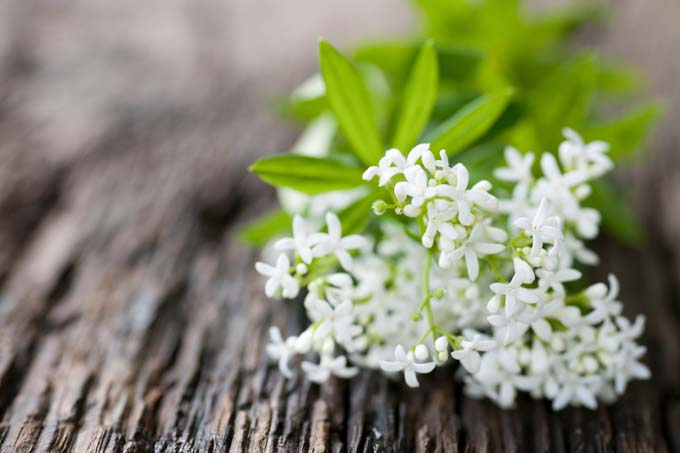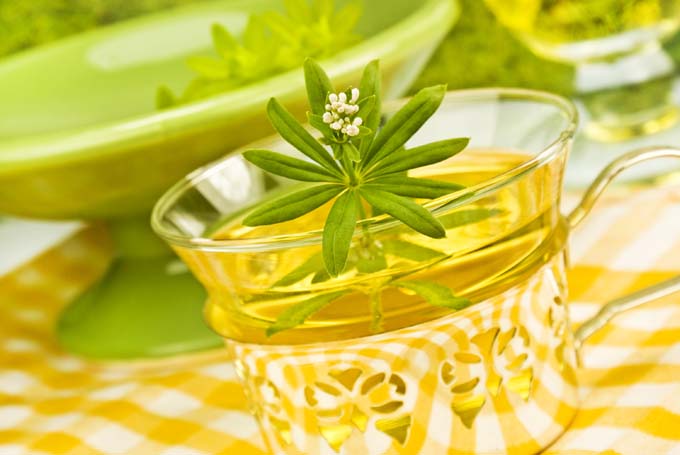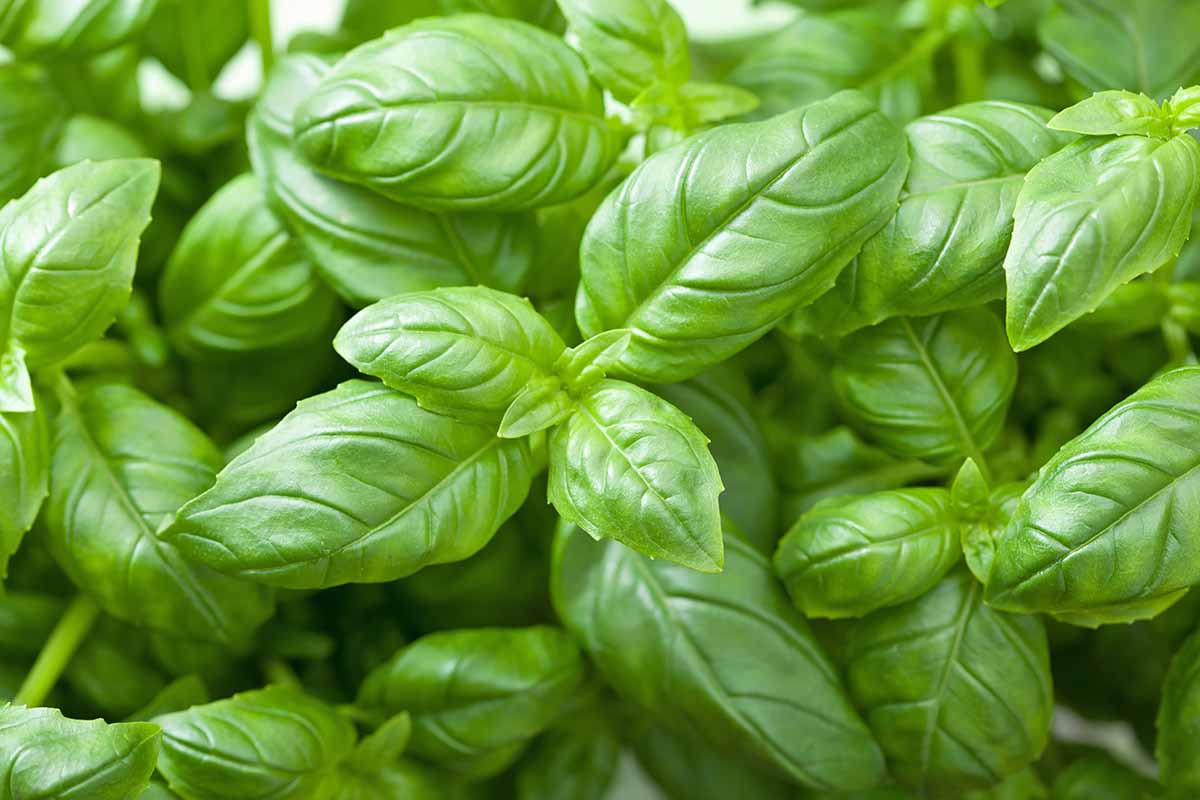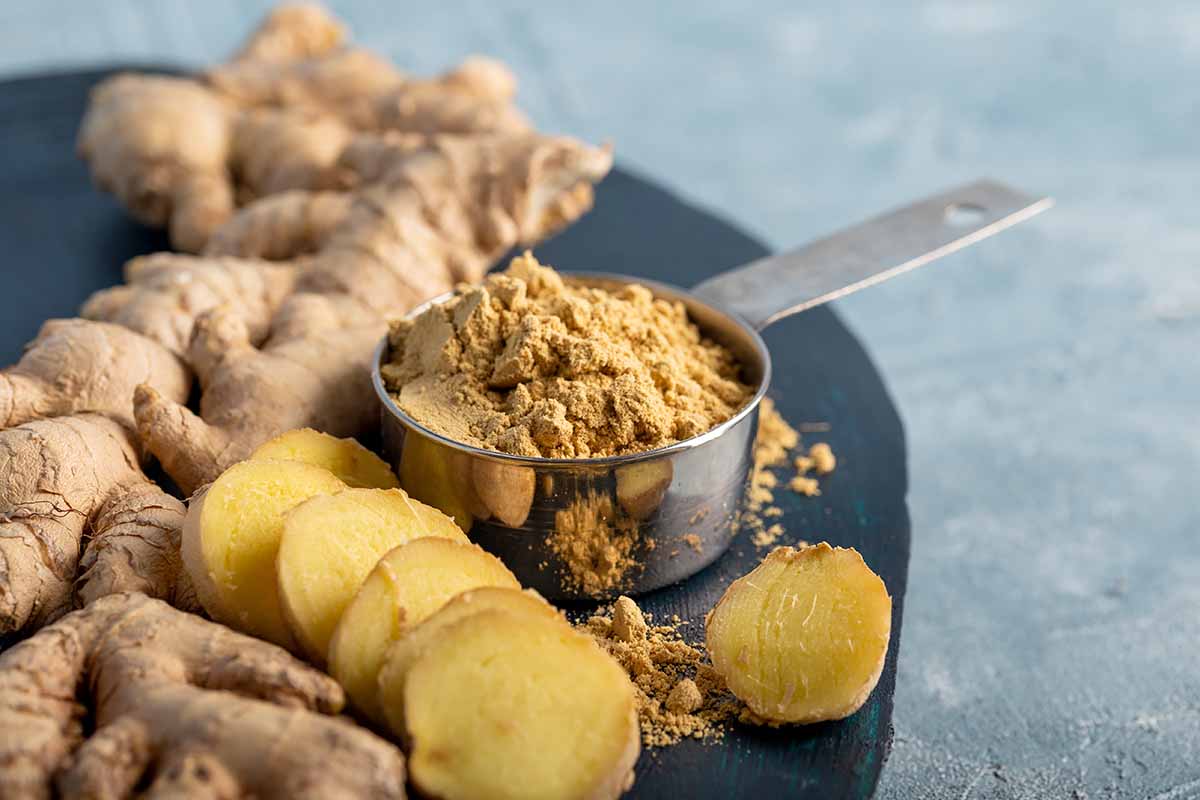Woodruff, a plant native to areas of the Middle East and most of Europe, thrives in the shade of deciduous forests and carefully cultivated gardens. This small, shade-loving plant grows 4 to 8 inches tall, and is a member of the Madder family.

When used in gardens, it will spread and fill in beautifully, although left unchecked it may quickly take over. This herb can be considered invasive; therefore herbalists should take care to keep an eye on the boundaries designated for its cultivation.
Closely related to henna, the plant has a slightly bitter taste and no aroma. In contrast, when wilted or crushed, woodruff releases a sweet, pleasant odor reminiscent of fresh hay.
During the Middle Ages, the herb was hung out to dry, crushed, and sewn into bags to keep clothing fresh. It was also used as a stuffing for mattresses and pillows. Known for its sleep-inducing properties, woodruff pillows were a welcome addition in any home.
Medicinal Properties
According to surviving Medieval texts, it was also a popular diuretic, in addition to its use in stimulating the liver.
Administration of the herb was done in a variety of ways:
- Dried leaves were steeped and consumed as tea.
- Tonics were made to drink throughout the day.
- A powdered version was mixed with fruit or honey.
- Compresses were made and applied to the forehead (Note: do not allow the pulp to touch the skin).
- Freshly crushed woodruff was a popular ingredient in potpourri and sachets.
For some unknown reason, moths avoid the herb’s aroma, which leaves me asking: why use those nasty mothballs? Go the natural route instead!
Woodruff should be harvested before or just after it begins to flower. In making homeopathic remedies, only the top portion of the plant should be used. Leaves are sometimes used for healing wounds.
The coumarin glucosides contained in the plant ferment as they dry, producing coumarin and dicumarol, its medicinally active ingredients.
These ingredients both act as anticoagulants and help to counteract excessive clotting of the blood. Anyone with circulatory problems or who is using medication for thinning the blood should not use this plant under any conditions, as it may cause internal bleeding when taken in large doses.

Used both internally and topically, this herb has been taken for symptoms of intestinal discomfort, abdominal cramps, headaches, migraines, and varicose veins. It is also believed to have properties beneficial for strengthening the heart, and has been used as a treatment for kidney stones, bladder stones, and liver disease.
Culinary Use
On a lighter note, it is also harvested for many reasons that have nothing to do with medicine. In Germany, woodruff has been harvested for years as an addition to both alcoholic and non-alcoholic beverages, the most popular use being a flavoring for the region’s famous May wines.

Bitter in taste, this plant is not used for cooking. But in Germany, the freshly cut shoots are traditionally steeped in white wine and enjoyed on May Day (May 1st). May wine is an acquired taste.
The herb is also a popular German addition to bowles (spiked punch), jellies, sorbets, creams, and salads, and for those tea drinkers among you, sweet woodruff is said to make a great cup of tea.
Sweet Woodruff Tea
- Steep one teaspoon of dried or fresh leaves in one cup of boiling water.
- Sweeten to taste (honey, raw sugar and stevia all make good additions).
A Note of Caution
The health information in this article is not intended to assess, diagnose, prescribe, or promise cure. Consult with your health care professional before considering any natural supplement or remedy for your health and wellness.
Have you tasted woodruff? Tell us about it in the comments! And if you’re looking for more herb and spice ideas, be sure to take a look at our complete A-Z guide.
The staff at Foodal are not medical professionals and this article should not be construed as medical advice. Foodal and Ask the Experts, LLC assume no liability for the use or misuse of the material presented above. Always consult with a medical professional before changing your diet, or using supplements or manufactured or natural medications.
Photo credits: Shutterstock.




This is why I love this blog; I always learn something new! I had never even heard of woodruff before I saw this on the front page. I have made it a personal goal to find some and make the tea that you described here! Thank you so much for the ever informative articles!
Mimsee- I’m always learning something new, and the Woodruff tea is spectacular. I admittedly only drink tea during the winter months, but I love experimenting with new and different blends.
Did you find any?
????
Here in Germany we have lots in the Forest.
I love this because its basically the taste of my childhood.
Just dry the leaves for 2 days, cook them in 600ml water, 800g sugar and then let the whole thing cool and sit for 3 days. Filter the leaves out, add in a little lime and mint and you got a really nice tasting syrup.
Yum, thanks for sharing!
I also have never heard of this plant before. I like all the different uses this plant has, like most plants that have been around for centuries. I wonder if this plant would grow in the area where I live, since I would love to grow this in my garden and use it in it’s dried state for it’s natural sleep inducing properties.
Kenna25- Woodruff is a great aromatic addition to any garden, and it smells heavenly. The plant thrives in shaded areas, thus, you wouldn’t want to plant it in an area of full sun. On another note….. it can also become invasive, spreading into other areas. If you decide to make it a part of your landscape, be sure to spade around the edges each spring. Its roots are runners, so make sure to cut them clean through.
Add me to the list of people that had never heard of Woodruff before. I don’t even think we have this in my part of the country. I will have to look into it because I would love to have it in my garden if only for the dainty and sweet little white flowers. I think it would look lovely. It never ceases to amaze me about all the medicinal plants that Mother Nature has blessed us with.
Nids- I don’t know what part of the country you live in, but sweet woodruff grows well in most any area with damp soil. If you live in a dry climate, you’ll need to water the woodruff to keep it hearty.
I have never heard of the said herb, it has such a comical name to it, but the qualities within fill me with utter awe, time to trash out those naphthalene balls {moth balls}…sleep inducing properties, who knew 😉
Off-topic, another herb i’d really like to know of would be the Rosemary herb, any gold nuggets of knowledge and wisdom in that regard? Will appreciate 🙂
Dianethare-
I’m glad you enjoyed the article. I love tracking down those elusive tidbits that are so often overlooked….. must be the teacher (or student) in me! An article on rosemary sounds like a great idea…. I’ll get started on that! Thank you….. 😀
Waiting with bated breath in regard to the rosemary herb article…:). I so love this blog, wonderful information, insightful and fresh day in, day out…i confess i’m totally hooked 😉
Dianethare- I have two articles in the preparation stage…. one is Rosemary. The research involved has been fascinating. Thus, I’m taking my time with it….. so much I want to include. Thanks for stopping back! Enjoy your reading.
Very interesting! I wonder if it is regularly grown and sold in my country. It is amazing what some of these herbal plants abilities are and we tend to rather on synthetic medicines rather than the natural ones.
Kitty,
What country are you from? I’d be happy to look into that for you! Thank you for reading….
I had no idea woodruff could be eaten or that it had other properties. I always thought of it as just a wild flower. It can easily be grown in the UK so I may consider adding it to my herb garden now.
missbishi- It’s a win/ win addition, and awfully pretty to boot. I don’t think you’d be sorry! Thank you for reading and commenting. Your comments are appreciated.
First time hearing about this one. Is it known by other names? I feel like I’ve tried it before but not under the ‘woodruff’ moniker. I don’t think I have the skills to tend to this in a garden but I’m sure I can find it in one of the many ethnic markets where I live. Suggestions?
Joan- There are a variety of different woodruff teas available on the internet if you can’t locate anything locally. Amazon also carries a number of dried herb packets for tea and brewing. Thanks for stopping by!
I know it as Waldmeister ……great herb.
Sweet Woodruff used to grow rampantly in my old garden and I never found a use for it. I wish I had know that moths did not like it because we had a use problem with clothes moths in that house. I have the same problem now, in our current house and now know a solution, so thank you. It is such a pretty little thing that getting in this garden (in a pot) would be well worth while and the bees always loved it.
Connie- I agree completely, woodruff is a beautiful plant….. I can remember my grandmother twining the blossoms and making little wreaths of flowers. They didn’t last very long, but they’re a favorite memory. Good luck with the moths…. let me know how it all works out for you.
As many uses as you talked about, I can’t believe I haven’t heard of this before. Off the top of my head I have 3 uses for it right now, (getting rid of moths, helping my husband sleep, and as a diuretic…)
I haven’t even started thinking about all the uses I would have for it while cooking. This is going in my herb harder, definitely! Thank you for this! It’s very helpful and a really interesting read, as well.
Kana-Marie- Happy to have provided you with the information and ideas! Thank you for commenting and reading! 😀
I only recently heard of woodruff, and am surprised at how many uses it has. I love that it can be used in food and beverages, as well as to freshen the air, and enhance sleep. I need a new eye pillow, so after reading this, I’m going to consider adding in woodruff when i make it.
Woodruff is a new herb to me. I’m another one who’s amazed that we rely so much on manufactured medicines and products, when an herb like this exists with so many medicinal and practical properties. I think on my restless nights I would very much appreciate a woodruff pillow, haha. And I’d love to try out woodruff tea!
I once knew someone with the surname Woodruff. I had no idea it was actually a plant. This is a very interesting and informative article. I have never seen this plant where I live, but if I ever do come across it, I will know what it is.
I planted woodruff as a groundcover years ago in part of my garden. It is invasive, and had I not read this informative summary of its beneficial uses, I might have ripped some of it out as a weed! I will definitely be drying leaves this year to make some sachets for my woolens and for my wool yarn storage. And perhaps trying it as a tea when I feel a bit bloated. Thank you for pulling all of this information together!
I have never head of woodruff. The flowers look beautiful I might plant them in my garden. It’s hard to find blooms with white blossoms these day, they make a nice addition to the negative space. If they actually deter moths then I really need to get some. I have too many suspicious holes in my sweaters. I don’t even know how they get in my closet. I just pull out a sweater and bam! New holes. Why the top is the only edible part, can they stems be eaten too? Is there some kind of toxic chemical compound in the stems? Also does its pain relieving properties work on menstrual cramps too? I have to try making some of the tea. I like things that look light and sweet.
Thank you for this great article Jill, and for introducing us to this gorgeous flower and its many uses. It’s is really quite beautiful. I read in the article that in the past the Woodruff was used as compresses and then placed on the forehead. My question is, why can’t the pulp touch the face? Does it burn, stain or scar the face? On another note, I would really like to smell and taste the Woodruff. It’s taste might be as delicate as its appearance.
It’s always interesting and useful to learn things like this, I haven’t seen this in my country but who knows, maybe it’s a thing here too!
I’m also a big fan of teas and after hearing all the good things that this little herb does for our health, the tea seems a wonderful idea, and it can be really helpul for me, specially on finals where the stress just don’t let me sleep well.
I see this plant everywhere during May here in France and never realized that it had these uses. I’m too late for this year (by only a couple of weeks) – but I shall try it out next year.
I’d heard of it, but not how to use it. This is great information! I can try checking some herb stores and some health food shops to see if they carry it. Is it better used fresh or dried? I may have to find it fresh, because I don’t think it grows naturally in my area. The idea of making May wine with it sounds really fun, and since most of my friends are Ren Faire people, I think they would enjoy it to. This is a very fascinating and useful post! Thanks!
I also had not heard of this herb before but think it is very pretty and potentially useful. I will help to research it a bit more and see how to manage growing it – I don’t want anything taking over my garden, but then again, this is prettier than many of the weeds I currently get!
Like MichelleV, I am curious as to why you can’t let the pulp touch your face…
Good Information Thank You
I used sweet woodruff, mugwort and 24 inches of fresh yarrow leaf in my first batch of gruit. Gruit is a term once used to designate beer made with herbs other than hops to preserve it. The coumarin level in my brew gave me a boost for a couple hours. Then I slept just fine. I think this is the type of ale that folks came to drink at high Holy days. After a long day in the field, a glass of this will make you feel like celebrating and still be ready for the morrow.
A caveat: more coumarin is not better. My second batch I tried twice as much yarrow. My heart pounded for hours into the night, so I only drank it at noon. Good thing it was an amber recipe with alcohol by volume about 4.5%.
I live in Pennsylvania and have alot of woodruff growing under my deck. I will have to experiment now!
I’m from Germany and I really like woodruff smell and flavour in beverages, ice cream etc.
But since this is not mentioned in the text above, I would like to inform you that woodruff can also cause headaches and dizziness if consumed too much and may even damage your liver if consumed too often.
Since 1974 in Germany it is not allowed to aromatize lemonades and candy, which are manly consumed by children, with real woodruff. Today they mostly use artificial woodruff flavour in foods.
So if you use real woodruff for teas or other beverages you should be really careful not to overdose it!
The recommended maximum dosage is 3g fresh leaves in 1 Liter of liquid.
So enjoy your woodruff tea or beer, but please be careful, especially when serving it to children!
Stefanie from Germany
I stumbled over your blog when I searched info about sweet woodruff. I learnt about this plant at a wildplants market and it was sold out, but it grows in forests. So yesterday I finally found it, but I’m new to this plant and this page gives me quite interesting info. As the Stefanie from Germany writes, I think we can agree, that the thumb rule is with all plants, do not use in excess, I believe it’s even with chamomile, I’d say less is better. Even cocoa or cacao powder has properties that aren’t healthy in high amounts.
I’d like to plant it in my community garden lot in a shady spot, I read it spreads out, so I have to pay attention to it. I’d like to harvest woodruff for tea and make perhaps a sleeping pillow with lavender.
Herbal greetings from Switzerland